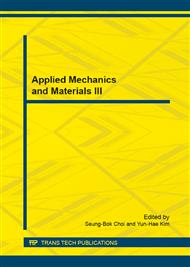[1]
K. L. Wong, M. J. May, P. Beiersdorfer, K. B. Fournier, B. Wilson, G. V. Brown and P. Springer, Phys. Rev. Lett. 90 (2003)235001.
Google Scholar
[2]
B. Denne, E. Hinnov, Phys. Scr. 35 (1987)811.
Google Scholar
[3]
J. P. Quintenz, D.D. Bloomquist and R. J. Leeper, Prog. Nucl, 30(1996)183.
Google Scholar
[4]
M. E. Foord, S. H. Glenzer and R. S. Thoe, Phys. Rev. Lett. 85(2000)992.
Google Scholar
[5]
S. H. Glenzer, K. B. Fournier and B. G. Wilson, Phys. Rev. Lett. 87(2001)045002.
Google Scholar
[6]
K. Honda, K. Mima and F. Koike, Phys. Rev. E 55(1997)4594.
Google Scholar
[7]
P. Palmeri, P. Quinet, Atom. Date Nucl. Data Tables 93(2007)537.
Google Scholar
[8]
Z. W. Wu, C. Z. Dong and J. Jing. Phys. Rev. A 86(2012)022712.
Google Scholar
[9]
J.L. Zeng, G. Zhao and J.M. Yuan, Atom. Date Nucl. Data Tables 93(2007)199.
Google Scholar
[10]
S.B. Utter, P. Beiersdorfer, E. Träbert. Phys. Rev. A 67(2003)012508.
Google Scholar
[11]
P.H. Norrington, 2002, Available from : <http: /www. am. qub. ac. uk/>.
Google Scholar
[12]
I.P. Grant, B.J. McKenzie, P.H. Norrington, D.F. Mayers and N.C. Pyper, Comput. Phys. Commun. 21(1980)207.
Google Scholar
[13]
B.J. Mckenzie, I.P. Grant and P.H. Norrington, Comput. Phys. Commun. 21(1980)233.
Google Scholar
[14]
K.G. Dyall. I.P. Grant, C.T. Johnson, F.A. Parpia and E.P. Plummer, Comput. Phys. Commun. 55(1989)425.
Google Scholar
[15]
I.P. Grant, Phys.B. 7(1974)1458.
Google Scholar
[16]
J. F. Seely, J. O. Ekberg and C. M. Borown, Phys. Rev. Lett. 57(1986) 2924.
Google Scholar
[17]
J. L. Zeng, G. Zhao and J. M. Yuan, Atom. Data and Nuclear Data Tables, 93(2007): 199.
Google Scholar
[18]
P. Palmeri, P. Quinet, É. Biémont and E. Träbert, At. Data. Nucl. Data Tables 93(2007)537.
DOI: 10.1016/j.adt.2006.12.003
Google Scholar
[19]
S. Song, F. Peng and G. Jiang. J. Phys. B: At. Mol. Opt. Phys. 39 (2006) (2087).
Google Scholar
[20]
L. Hao, G. Jiang. Atom. Data Nucl. Data 94 (2008) 739.
Google Scholar
[21]
F. Hu, G. Jiang, W. Hong and L. Hao. Eur. Phys. J. D 49 (2008) 293.
Google Scholar
[22]
H.J. Hou, G. Jiang, F. Hu and L. Hao. Atom. Data Nucl. Data 95 (2009) 125.
Google Scholar
[23]
L. Zhang, G. Jiang, L. Hao and B. Deng. Phys. Scr. 83 (2011) 025302.
Google Scholar
[24]
L. Hao, G. Jiang. Phys. Rev. A 83(2011)012511.
Google Scholar
[25]
M. Xu, G. Jiang, B.L. Deng and G.J. Bian, Atom. Data Nucl. Data Tables, 100 (2014)1357.
Google Scholar


